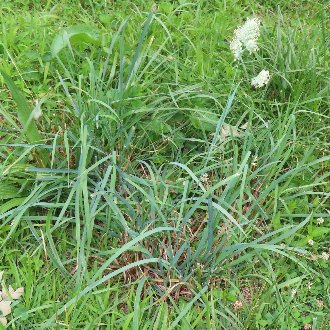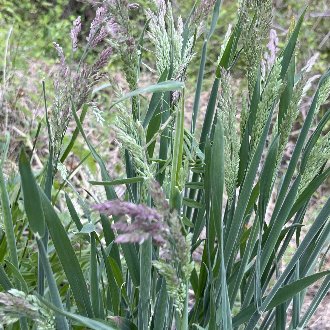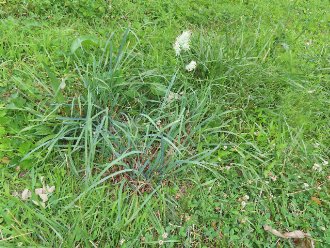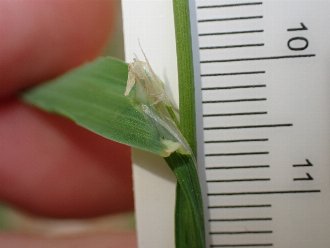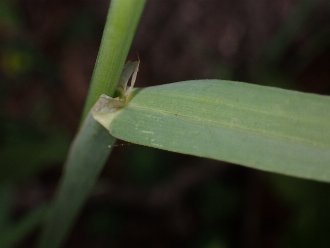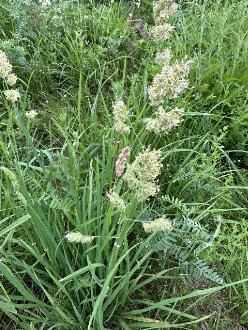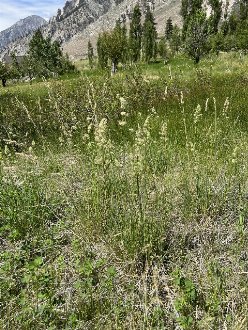Orchard Grass (Dactylis glomerata L.)
Also known as orchardgrass, cat grass.
↑Summary
A perennial cool-season bunchgrass, widely planted as a pasture grass, that has become invasive.
↑Range - Expand
| Legend | Color |
| Introduced | |
| Introduced or Not Present |
This tentative map is based on our own research. It may have limited data on Canada and/or Mexico, and there is some subjectivity in our assignment of plants as introduced vs. expanded. Read more in this blog post.
Although this plant occurs somewhere in each of these regions, it may only occur in a small part of some or all of them.
↑Similar Plants
↑Habitat
Found across North America in climates receiving at least 12 inches (305mm) of rainfall annually. In the West, it is mostly limited to higher elevations, typically 4,900 to 6,200 feet (1,500-1,900m) whereas in the East it ranges to sea level.
Wild habitats include grasslands, savannas, woodland borders and openings, and thickets. Frequent in anthropogenic habitats, including pastures, where it is often intentionally planted, and abandoned agricultural land where it frequently persists, orchards, anthropogenic forest edges such as power line clearances and roads or larger paths through woodlands, fencerows, weedy margins of suburban gardens and parks, and other disturbed ground with rich soil. In much of its range it is more common in bottomlands, but in humid regions it also can be found on upland sites.
Prefers partial sun but tolerates full sun on sufficiently moist sites, and light shade as long as at least some dappled sunlight reaches plants. This species is among the most shade-tolerant of grasses that are also able to survive in full sun. Prefers rich, fertile soil of relatively neutral pH, and loamy soil, tolerating some gravely or clayey material in soil. Found in conditions ranging from moist to slightly dry, but requires good drainage.
↑Life Cycle
Orchard grass is a long-lived, perennial, cool-season bunchgrass. Seeds do not exhibit any dormancy requirements and can germinate immediately upon falling. Germination is triggered by moisture availability, and usually happens in fall when soil conditions become moister.
Growth of established plants begins in early spring. Foliage growth is optimal at temperatures close to 70°F (21°C). Plants flower some time between May and October. Flowering is triggered by temperature and not light. In dry climates and on drier sites in humid climates, plants become dormant in summer, with a second flush of foliage occurring in fall. Some populations (particularly those derived from northern European populations) will be dormant in summer even when moisture availability is sufficient, but others (particularly those derived from Mediterranean populations) will grow continuously through summer if sufficient moisture is available. Basal foliage is evergreen.
Seedheads shatter and distribute their seed in late summer or into fall on late-blooming plants. Nearly all seed is distributed immediately. This species does not form a persistent seed bank, with few seeds surviving beyond the first fall following their distribution.
Plants become more vigorous over time, reproducing vegetatively by short tillers, with clumps tending to increase in size and vigor each year. Plants tend to clump more on sites with high soil nitrogen content, being smaller and more distributed on lower-nitrogen sites.
Individual plants often live 10-20 years on favorable sites, and are usually killed by competition from other species.
↑Faunal Associations
Orchard grass is a preferred forage species for domestic livestock, and it tends to be browsed preferentially by livestock. Deer will forage on this species sparsely, and do not seem to prefer it the way domestic livestock do; they often are deterred from browsing in areas where it is dominant. Rabbits may browse this grass more than deer.
This species is better than some introduced species at supporting insects, which may be a function of it being so widely planted, to where some of the insects that eat it have also been introduced from other continents, and also more native species have adapted to eat it. The green-striped grasshopper (Chortophaga viridifasciata), a generalist, eats this grass, and other grasshoppers likely do as well. The toothed flea beetle (Chaetocnema denticulata), corn flea beetle (Chaetocnema pulicaria), and the cereal leaf beetle (Oulema melanopus), which was introduced from Europe, also eat the foliage. The latter two of these beetles cause significant damage to cultivated crops, and as such the presence of this grass in agricultural regions can pose a hazard to crop production. The larvae of the grass sheathminer fly (Cerodontha dorsalis) mines the sheaths of this and other grasess.
Quite a few lepidoptera eat this grass in the larval stage, including the red-shouldered ctenucha moth (Ctenucha rubroscapus), which eats various grasses and sedges, favoring cool-season species including this and Elymus (wildryes), and the Zabulon skipper (Lon zabulon), which eats many different grasses. The introduced European skipper (Thymelicus lineola) eats this and many other grasses introduced from Europe. The moths Dargida albilinea and Dargida tetera, which we found little info on, has been recorded eating this species, and the wheat head armyworm (Dargida diffusa), probably introduced from Europe, eats this species and especially prefers the also-European timothy (Phleum pratense). It has been recorded being eaten by the possibly-endangered hop vine borer moth (Hydraecia immanis) which is native to North America and probably prefers other species.
↑Control
Orchardgrass is relatively easy to remove from sites due to the fact that it does not form a persistent seedbank. However, because it is so widespread in the environment due to planting by humans, and the fact that many landowners and managers see it as a desireable plant, it frequently reestablishes. Its shade-tolerance makes it tend to persist on a site in the absence of active attempts to remove it.
When isolated clumps of this species occur, especially if they are caught early on before they become too vigorous, they can be easily uprooted by hand, then the plants left in place to dry out and die. Timing is key: plants must be removed before seed is produced, or the seed will simply resprout in the upcoming fall.
Controlled burns carried out in spring, before warm-season grasses emerge, often will mostly kill this species. However, it readily recolonizes recently-burned sites, so this approach is not effective if any plants are allowed to go to seed, or if there is another seed source nearby. In these cases, burning can sometimes cause this species to increase. A burn-based approach is most effective if there are already native warm-season grasses present in the seed bank which can emerge following the burn, and if there are no native cool-season grasses already present on the site.
Herbicide can also be effective for controlling this species, especially when applied early in spring before most competing plants have emerged. Applying herbicide later in the season after seed has been distributed often favors this plant by killing competing plants and creating more space for this species to germinate.
Competing native plants that occupy a similar niche can prevent reestablishment. Many wildryes (Elymus) are native perennial cool-season bunchgrasses that often occupy a similar niche. Virginia wildrye (Elymus virginicus) is the species that overlaps most with this one in range; it prefers slightly moister conditions although with much overlap in habitat preferences.
↑Uses
Orchard grass is one of the most widely-used pasture grasses in North America and is widely planted for this purpose. It is also used for hay and silage. It is considered one of the best forage grasses and a preferred food for all grass-eating livestock.
It is also planted in Montana on ski slopes to stabilize the slopes and suppress unwanted annuals.
↑Related Plants
Orchard grass belongs to a clade of grasses none of which are native to North America. This is the only species of its genus found in North America. It is also closely related to goldentop grass (Lamarckia aurea), which is introduced only in the southwest.
It is slightly less closely related to crested dogstail grass (Cynosurus cristatus), bristly dogstail grass (Cynosurus echinatus), ferngrass (Catapodium rigidum), memphisgrass (Cutandia memphitica), barbgrass (Hainardia cylindrica), curved sicklegrass (Parapholis incurva), and strigose sicklegrass (Parapholis strigosa). All of these are introduced, and most tend to be limited to the west coast and/or southwest.
The closest-related native species, slightly less closely related than those above, are those of the Deschampsia genus, hair grasses or tussock grasses, of which there are 6 species native to North America.
↑Notes
This species has all the hallmarks of an invasive species: it is native to Europe and introduced in North America, and is aggressive and can spread into wild habitats, displacing native plants. Although it tends to get replaced by native herbaceous plants and trees over time, this process can take up to 20 years, and the presence of this grass can hinder the establishment of native vegetation.
In spite of its functioning more-or-less like other invasive species, there has been reluctance to label it as such because it is so widely used in pastureland and as a forage crop.
This species is sometimes referred to by the common name "cat grass", but we recommend avoiding this term as it is also used, generically, to refer to any number of grasses that people grow indoors that cats like. The common name "orchard grass" is unambiguous.
↑Links & External Resources
• Orchardgrass | Fire Effects Information System (FEIS) (About This Site)
• Dactylis glomerata (Orchard Grass) | Illinois Wildflowers (About This Site)
• Dactylis glomerata (orchardgrass) | USDA PLANTS Database (About This Site)
• Dactylis glomerata | Go Botany (About This Site)
• Orchard Grass | iNaturalist (About This Site)
• Dactylis glomerata | Biota of North America Project (BONAP) (About This Site)
• Dactylis glomerata | NatureServe Explorer (About This Site)
• Dactylis glomerata | Flora of North America (About This Site)
• Dactylis glomerata | Missouri Plants (About This Site)
• Orchard Grass | Maryland Biodiversity Project (About This Site)
• Dactylis glomerata L. (Orchard Grass) | Digital Atlas of the Virginia Flora (About This Site)



